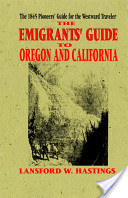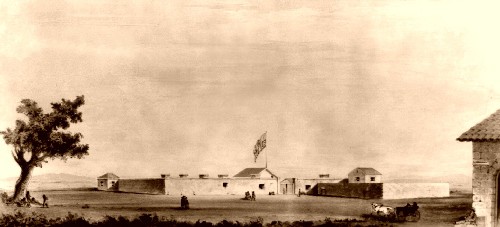
One of the more sensational stories of the Oregon Trail is that of the Donner party, the group of emigrants to California in 1846 who were lost in snows in the Sierra Nevada mountains from November 1846 until March 1847, and allegedly resorted to cannibalism. As soon as their story became public, their tale became infamous.
I don’t mention the Donner story in my novel about the Oregon Trail emigrants, because word of this disaster did not reach the East Coast until July 1847, and my wagon train left Missouri in April 1847. At some point along the way, they might have heard of the tragedy, but it would not have changed their decision to go West.
The Donner story did affect emigrants in later years, but by that time the trails were better marked, and later groups did not face the unblazed path through the Sierras that the Donners took. Moreover, the gold fever that hit most travelers after mid-1848 overshadowed anything they might have heard about the Donners.
The Donner party left Independence, Missouri, in mid-May 1846, later than advisable for the long journey West. In fact, this group was near the end of the 1846 exodus from Independence.
 But their real problems began in July 1846, when they took a shortcut to California advocated by Lansford Hastings. Hastings had published a guide in 1845 entitled “The Emigrant’s Guide to Oregon and California,” which described the most direct route for emigrants to California. He advised readers to leave the Oregon Trail at Fort Bridger, go west southwest to Salt Lake, and then rejoin the old California Trail near what is now Elko, Nevada.
But their real problems began in July 1846, when they took a shortcut to California advocated by Lansford Hastings. Hastings had published a guide in 1845 entitled “The Emigrant’s Guide to Oregon and California,” which described the most direct route for emigrants to California. He advised readers to leave the Oregon Trail at Fort Bridger, go west southwest to Salt Lake, and then rejoin the old California Trail near what is now Elko, Nevada.
Hastings himself did not travel this route until early 1846, when he first led a group east from California. Even then, he didn’t have wagons with him. The emigrants of 1846 found that Hastings’s cutoff was not ready for wagons.
Hastings had promised to lead the travelers back to California, but the Donner party missed Hastings by about a week, and so followed behind his group. They had to build a road for their wagons through the Wasatch Mountains, which involved felling trees, moving huge boulders, and creating a narrrow path along canyon edges to get their wagons through.
Then they encountered more difficulties in the Great Salt Desert, where their wagon wheels sunk to the hubs in a gummy mix of sand and salt. It took six days to cross the 80 mile desert, with no water for their animals. They fell further and further behind Hastings.
By the time the travelers reached the Sierra Nevada and rejoined the California Trail, they were about a month behind schedule.
Then in early November the first blizzard of the terrible winter of 1846-47 trapped them near what is now Truckee, California. Most of the party holed up in cabins built by earlier pioneers at Lake Truckee (now called Donner Lake), where they were snowed in for five months. They ran out of anything to eat, including the meat and hides of their oxen, and suffered malnutrition, starvation, and other deprivations.

In December 1846 a small group of 15 from the Donner party set out on snowshoes to reach civilization. Due to cold, starvation, and disorientation, only seven survived to reach Sutter’s Fort (near what is now Sacramento, California).
Californians then knew that the emigrants were trapped in the mountains, but the winter weather and the Mexican-American War delayed rescue attempts. The war kept roads and communications blocked and made supplies unavailable.
In February 1847, the first group of rescuers reached the surviving members of the Donner party in the Sierras. Due to the weather and their weakened condition, it took several rescue groups to bring in supplies and lead the survivors to California. The last survivor arrived at Sutter’s Fort in late April 1847.
Of the 87 people in the Donner party, only 46 survived.

Far more has been written about the Donner party’s experience than I can recount here. If you are interested, read the diary kept by Patrick Breen (available on the Internet) or Desperate Passage: The Donner Party’s Perilous Journey West, by Ethan Rarick (Oxford University Press 2008). PBS also had a show on American Experience about the Donner party.
The letters and articles by survivors of the Donner party contain heart-wrenching accounts of starvation and illness, of parents and children watching each other die. They also contain subplots of murder and treachery. And the descriptions of the rescue attempts are as blood-curdling as the travails that happened in the cabins at Lake Truckee.
Of course, the lurid tales of cannibalism are why the Donner party is so famous. There are first-hand accounts of cannibalism, though some of the survivors denied it. Archeological evidence cuts both ways.
Who knows what any of us would have done, if our families were starving and freezing, with no prospect of rescue until spring? For me, more important than the sensational aspects of the Donner story are the reasons they got into the horrendous situation in the first place – they started their journey late, moved slowly, and took an untried shortcut.
…Remember, never take no cut-offs and hurry along as fast as you can.
This summary statement contains good life lessons for all of us.




This is so interesting, Theresa. I can’t wait to read Patrick Breen’s diary. Thanks for the link!
In other words, “Cuttin’ corners don’t work, nohow!”
Nice job! I laughed at the end line. I’m one to both take short-cuts and wander off looking at something or another….hardly ever hurry along on a trip. But, so far at least, I’ve never been eaten.
Reblogged this on delveawhile's Blog.
[…] The Donner Party: Don’t Take Shortcuts and Hurry Along […]